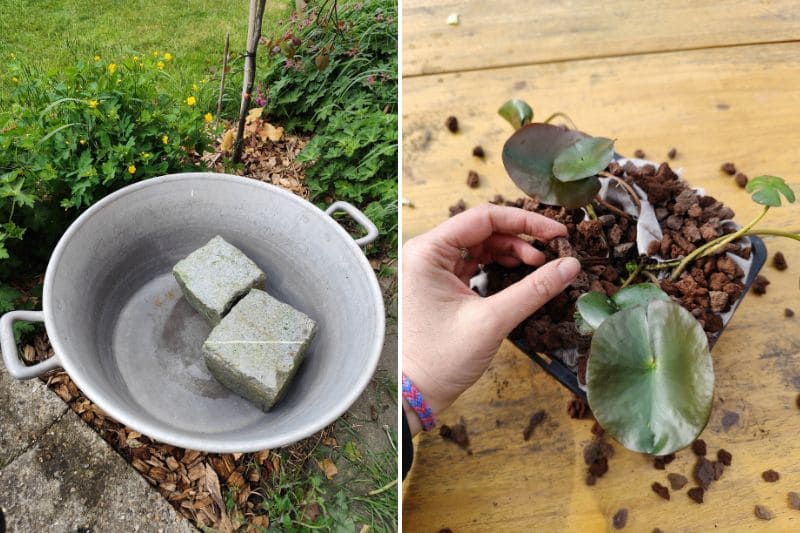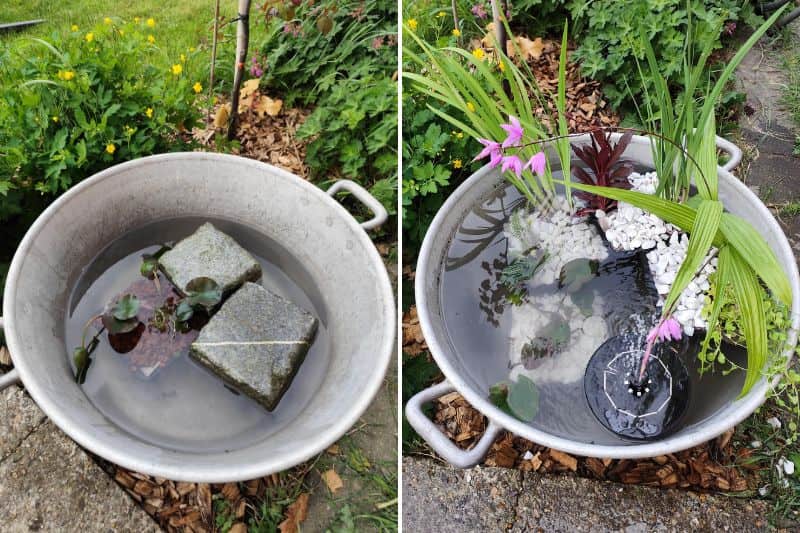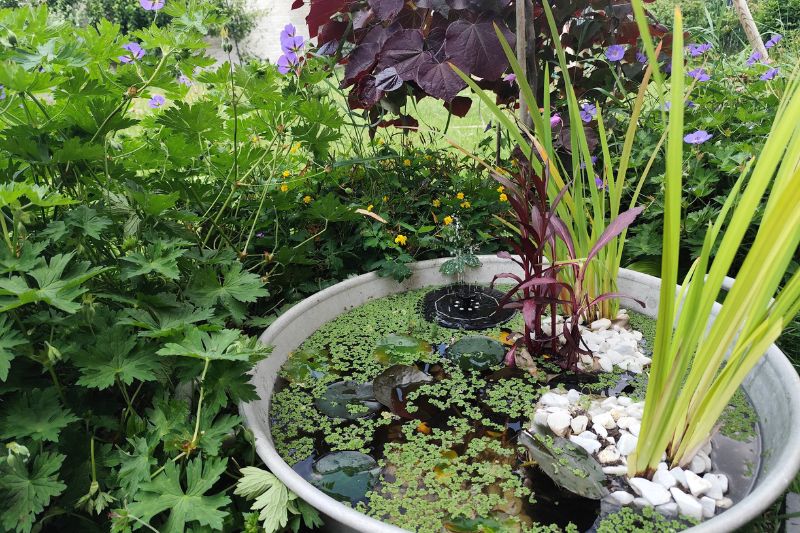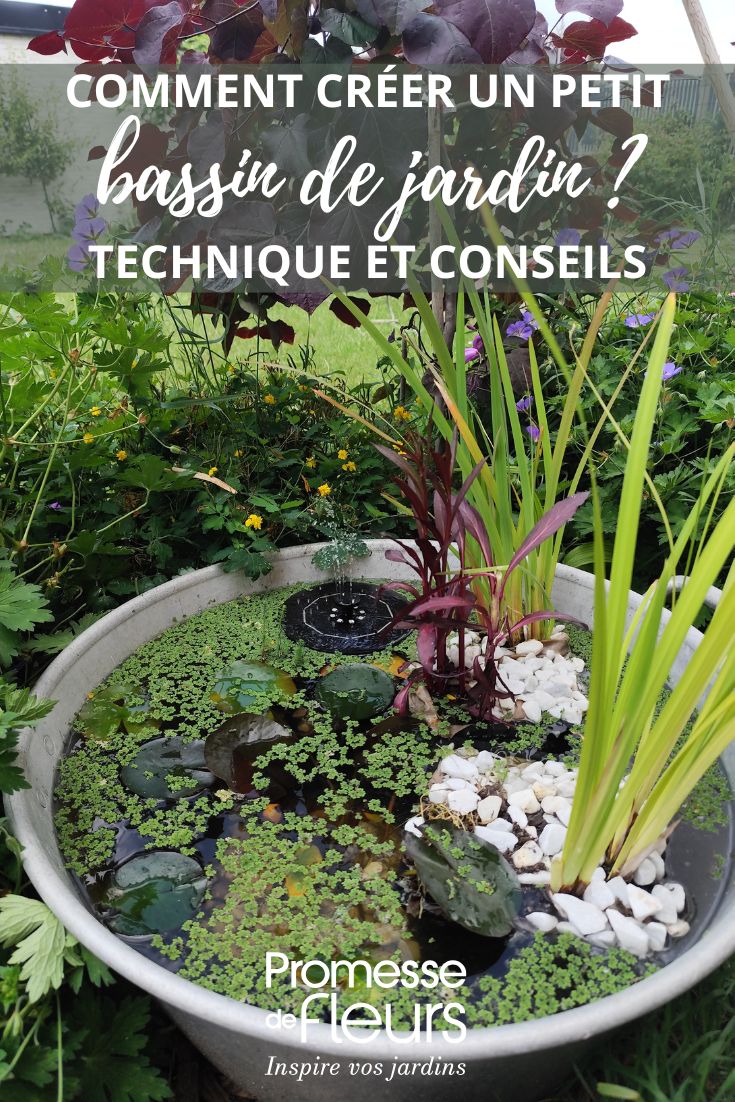Do you dream of installing a small above-ground pond in your garden or on your terrace? Easy to install and maintain, this type of mini pond brings freshness and serenity while promoting biodiversity. Discover, in this tutorial, how to step by step create your own small garden pond, choose your aquatic plants wisely, and follow a few simple steps for maintenance.
Steps to Install the Small Pond
1 - Choose the right location: For an above-ground pond, prefer a semi-shaded area. Too much sunlight leads to rapid evaporation of water and encourages algae growth. The ideal spot is a bright location without direct sunlight during the hottest hours.
2- Choose your container: you can use a half wooden barrel (lined with a plastic membrane), a large glazed terracotta or plastic pot (without a drainage hole), or a preformed above-ground pond. Here, I chose to use an old zinc basin that I found at a flea market.
3- Installing the plants: Place the plants in baskets for aquatic plants or small jute bags. Be sure to use heavy garden soil or special potting soil for aquatic plants, which is heavier than regular potting soil. Remember to cover the potting soil with gravel or pumice to prevent the soil from mixing with the water.

To accommodate the different depths tolerated by my plants, I placed stones at the bottom of the basin to raise some baskets.
? Alternative: you can also plant directly at the bottom of the pond, in soil.
4- Fill the small pond: If possible, use rainwater, which is softer and chlorine-free. If you use tap water, let it sit for a few days in the open air to allow the chlorine to evaporate before introducing the plants.

5- Optional: Install a small pump or fountain to promote oxygenation of the water, limit stagnation, and slow down the development of green algae.
? For children's safety, even a small above-ground pond should remain under constant supervision and be equipped with a grid or placed out of their reach.
Which Plants to Choose for an Above-Ground Pond?
It all depends on the size of your pond, but ideally, you need:
- 1 floating plant,
- 1 or 2 emergent plants to add height,
- 1 or 2 oxygenating plants.
Floating plants suitable for a small pond:
- Dwarf Water Lily (Nymphaea): hardy, with lovely floating flowers.
- Dwarf Lotus (Nelumbo): continuous flowering in summer and pretty round leaves.
- Frogbit (Limnobium laevigatum): floating round leaves, similar to water lilies. Oxygenating and filtering, it is sensitive to frost.
Emergent plants for a small pond:
- Water Aloe (Stratiotes aloïdes): fast-growing, forms a rosette of stiff, spiky leaves. Oxygenating and purifying plant.
- Flowering Rush (Butomus umbellatus): pink flowering in umbels, soft and hardy foliage.
- Pickerel Rush (Pontederia cordata): elegant blue flowers and upright foliage.
- Japanese Horsetail (Equisetum hyemale): very graphic, hardy, can become invasive.
- Dwarf Sweet Flag (Acorus gramineus): fine foliage, often variegated, ideal for small ponds.
- Mini Papyrus (Cyperus): decorative, to be brought indoors in winter.
Oxygenating plants for mini pond:
- Elodea (Elodea canadensis): submerged, hardy, oxygenating. Can be invasive.
- Marsh Featherfoil (Hottonia palustris): light foliage, pretty white flowers, useful for biodiversity.
- Hornwort (Ceratophyllum demersum): very effective in limiting algae.
- Water Buttercup (Luronium natans): small rare aquatic plant, hardy and well-suited for small ponds. Aesthetic floating foliage.

In the example above, I chose a dwarf water lily 'Berthold', two Iris ensata 'White Ladies' for their beautiful white flowers, a Water Buttercup to oxygenate the pond, a Lobelia 'Queen Victoria' to enliven the whole with its purple foliage and red flowers, and tiny water ferns (Azolla filiculoides).
Also find all our perennial pond plants.
Maintenance Tips for an Above-Ground Pond
- In spring, clean debris, prune the plants, and restart the pump (take the opportunity to clean it).
- In summer, monitor the water level, add rainwater if needed, and remove excess algae.
- In autumn, remove dead leaves, cut back faded plants, and prepare the pond for dormancy.
- In winter, bring non-hardy plants indoors (like water hyacinths or water lettuces), stop the pump, and insulate the pond's perimeter if possible.
Tips and Frequently Asked Questions
Biodiversity tip: place a flat stone, a branch, or a small submerged ramp to allow small wildlife (hedgehogs, insects, amphibians) to easily exit the pond if they fall in.
Can you install an above-ground pond on a terrace or balcony?
Yes, provided you check the strength of the support. A pond filled with water can be heavy: plan for a modest-sized container and place an insulating underlayer to protect the floor.
What depth is needed for a mini garden pond?
A depth of 30 to 40 cm is sufficient for most aquatic plants. For a dwarf water lily, count at least 20 to 25 cm of water minimum above the rootstock.
Is a pump necessary in a small pond?
It is not essential if the pond is well-planted and balanced, but a small pump or fountain helps oxygenate the water and limits algae. It is a real plus for water clarity.
Can you put fish in an above-ground pond?
In a very small volume, it is better to refrain. Fish quickly pollute the water, complicating the biological balance. Moreover, zinc basins like this one, even old, release toxic zinc for fish. However, aquatic plants naturally attract insects, amphibians, and other small forms of life.
































Comments